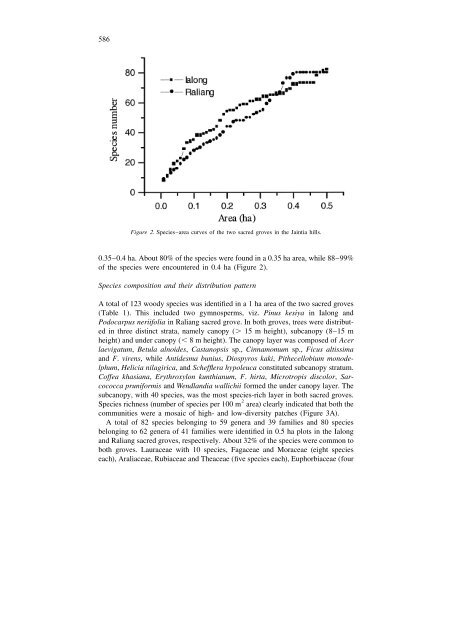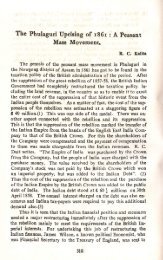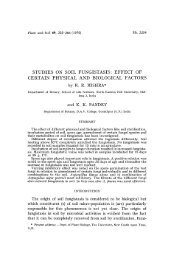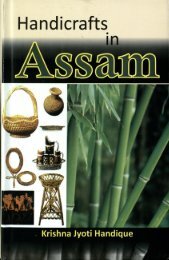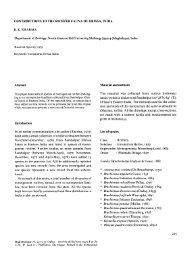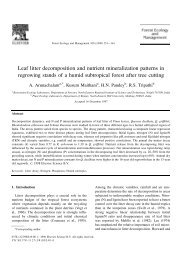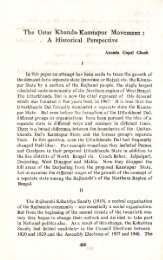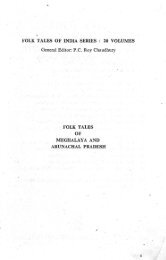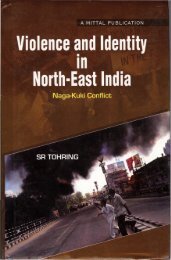Tree diversity in sacred groves of the Jaintia - DSpace@NEHU ...
Tree diversity in sacred groves of the Jaintia - DSpace@NEHU ...
Tree diversity in sacred groves of the Jaintia - DSpace@NEHU ...
You also want an ePaper? Increase the reach of your titles
YUMPU automatically turns print PDFs into web optimized ePapers that Google loves.
586<br />
Figure 2. Species–area curves <strong>of</strong> <strong>the</strong> two <strong>sacred</strong> <strong>groves</strong> <strong>in</strong> <strong>the</strong> Ja<strong>in</strong>tia hills.<br />
0.35–0.4 ha. About 80% <strong>of</strong> <strong>the</strong> species were found <strong>in</strong> a 0.35 ha area, while 88–99%<br />
<strong>of</strong> <strong>the</strong> species were encountered <strong>in</strong> 0.4 ha (Figure 2).<br />
Species composition and <strong>the</strong>ir distribution pattern<br />
A total <strong>of</strong> 123 woody species was identified <strong>in</strong> a 1 ha area <strong>of</strong> <strong>the</strong> two <strong>sacred</strong> <strong>groves</strong><br />
(Table 1). This <strong>in</strong>cluded two gymnosperms, viz. P<strong>in</strong>us kesiya <strong>in</strong> Ialong and<br />
Podocarpus neriifolia <strong>in</strong> Raliang <strong>sacred</strong> grove. In both <strong>groves</strong>, trees were distributed<br />
<strong>in</strong> three dist<strong>in</strong>ct strata, namely canopy (. 15 m height), subcanopy (8–15 m<br />
height) and under canopy (, 8 m height). The canopy layer was composed <strong>of</strong> Acer<br />
laevigatum, Betula alnoides, Castanopsis sp., C<strong>in</strong>namomum sp., Ficus altissima<br />
and F. virens, while Antidesma bunius, Diospyros kaki, Pi<strong>the</strong>cellobium monodelphum,<br />
Helicia nilagirica, and Schefflera hypoleuca constituted subcanopy stratum.<br />
C<strong>of</strong>fea khasiana, Erythroxylon kunthianum, F. hirta, Microtropis discolor, Sarcococca<br />
pruniformis and Wendlandia wallichii formed <strong>the</strong> under canopy layer. The<br />
subcanopy, with 40 species, was <strong>the</strong> most species-rich layer <strong>in</strong> both <strong>sacred</strong> <strong>groves</strong>.<br />
2<br />
Species richness (number <strong>of</strong> species per 100 m area) clearly <strong>in</strong>dicated that both <strong>the</strong><br />
communities were a mosaic <strong>of</strong> high- and low-<strong>diversity</strong> patches (Figure 3A).<br />
A total <strong>of</strong> 82 species belong<strong>in</strong>g to 59 genera and 39 families and 80 species<br />
belong<strong>in</strong>g to 62 genera <strong>of</strong> 41 families were identified <strong>in</strong> 0.5 ha plots <strong>in</strong> <strong>the</strong> Ialong<br />
and Raliang <strong>sacred</strong> <strong>groves</strong>, respectively. About 32% <strong>of</strong> <strong>the</strong> species were common to<br />
both <strong>groves</strong>. Lauraceae with 10 species, Fagaceae and Moraceae (eight species<br />
each), Araliaceae, Rubiaceae and Theaceae (five species each), Euphorbiaceae (four


